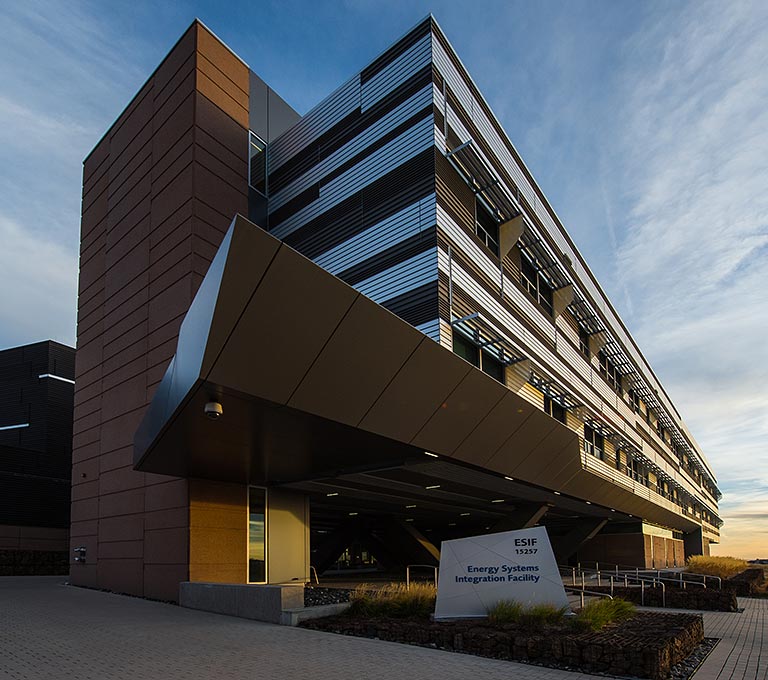Innovation Incubator Gives Rise to Virtual Building Control Tests

As part of the Wells Fargo IN2 program, NREL researchers will help a Colorado firm test its energy controller at the ESIF. Photo by Dennis Schroeder
A Colorado firm participating in the latest Wells Fargo Innovation Incubator (IN2) Program is partnering with NREL to refine its building energy management control systems—but there’s a twist. While it is common to install what’s called “hardware-in-the-loop” (HIL) to validate products by using physical devices, EdgePower is drawing on NREL’s building simulation competency to test its controllers virtually.
“We are putting their controller into a synthetic environment that is called ‘controller in-the-loop,’” said NREL Senior Engineer and Residential Systems Innovation & Performance Manager Dane Christensen, the principal investigator on the project. This environment builds on the HIL practice, commonly used in the Energy Systems Integration Facility (ESIF) as an experimental methodology to put pieces of hardware into realistic operational settings.
The benefit of HIL is that the new devices do not have exposure to the actual electrical grid. Now, NREL is taking such simulations one step further. “We’re basically picking up from that HIL experience," Christensen said, "and applying that concept to a control problem instead of a physical operation of a piece of hardware.”
This novel approach allows NREL to connect EdgePower’s controller with a variety of building types—without ever being there. “We are currently designing a software interface to their controller that looks exactly like it is a certain building. In one case, it might be a federal building in Denver. In another case, it might be a school down in Florida,” Christensen said.
Controller in-the-loop simulations enable NREL researchers to monitor the dynamics of buildings that use EdgePower's control architecture from afar. These scenarios allow the company to understand how their suite of services—such as dimming lights or changing temperature set points in a building—impact energy efficiency, reduce utility costs, and provide grid services. The virtual approach speeds up the research by avoiding lengthy site implementation barriers such as cybersecurity evaluations, installation approvals, and commissioning. This simulation also enables the team to perform multiple iterations in a short amount of time.
EdgePower, an Aspen-based firm selected this year to be part of the third cohort of IN2, already has systems installed in more than 500 sites. Customers include two Fortune 500 companies with large retail facilities and storage warehouses. The company’s products, both hardware and software, seek to minimize demand charges (costs associated with the instantaneous or 15-minute maximum energy consumption that occurs any during the billing period) through improved controls and analytics. NREL’s team will help them analyze prospects for other clients, with an eye towards installing new demonstration facilities next spring.
To aid in that, NREL also will perform cybersecurity analysis on EdgePower’s products. “With cybersecurity being a major issue, we thought it was relevant to do cybersecurity risk assessment, and evaluate what more the company could do to harden their systems,” Christensen said. "This could have multiple benefits: It would not only help EdgePower protect its business, it would also provide a valuable third-party risk assessment for new customers.”
As part of the IN2 Program, NREL has been collaborating with several other startup companies on early-stage commercial building technologies, including Whisker Labs’ peel-and-stick energy-metering system, LiquidCool’s server prototype, and Go Electric’s inverter. To learn more about IN2, download the 2017 Annual Report or visit the IN2 website.
By leveraging the laboratory’s core R&D strengths and providing the knowledge to integrate and optimize energy systems and renewable power technologies, NREL advances the science and engineering of energy efficiency in buildings, schools, communities, and districts. Through these advances, NREL is building new capabilities and exploring a broader vision of efficient buildings to enable an efficient, resilient, and reliable grid. Learn more by visiting NREL’s buildings website.
ESIF is one of the only megawatt-scale research facilities in the United States that enables integration studies at full power and actual load levels in real-time simulation. It is designed to be a connecting point for industry, academia, and government to work together to solve some of the most complex and important global challenges of our time.
Last Updated May 28, 2025
